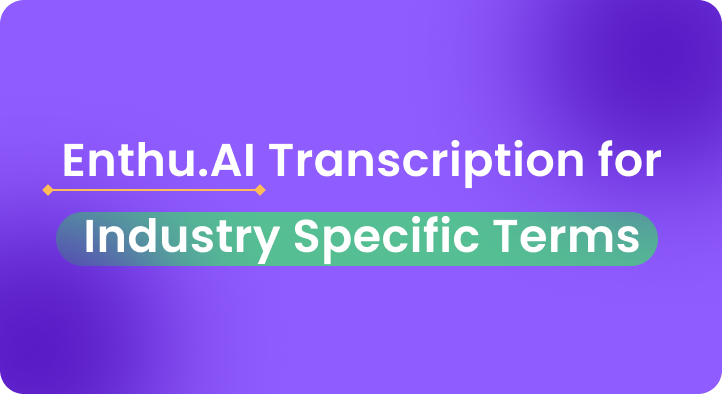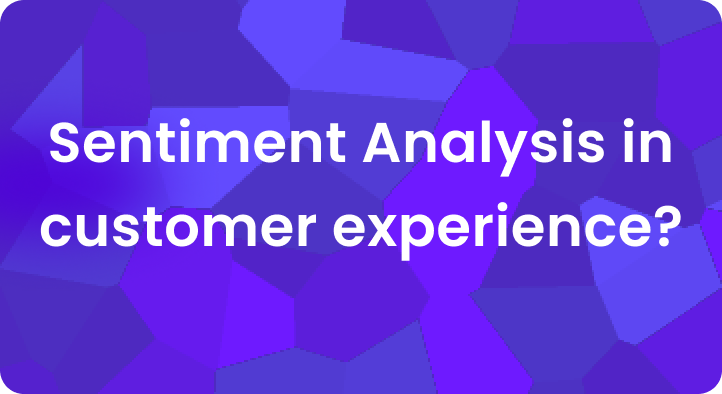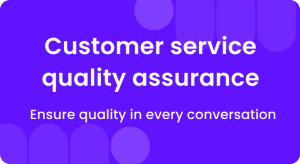Is your traditional coaching failing?
Still stuck in the “let’s talk about your calls for an hour” era? No wonder your agents are zoning out.
Modern call center coaching isn’t about marathon sessions or motivational quotes—it’s about fast, focused, and friction-free feedback.
And yes, it can actually be fun (or at least not soul-sucking).
This guide spills the tea on coaching styles that click, a 15-minute framework your agents won’t hate, and real-deal techniques to turn “meh” performers into stars.
Let’s ditch the coaching snoozefest and make it stick.
Call Center Coaching: 7 Proven Techniques + a 15-Minute Framework
Effective coaching is fast, focused, and ongoing, not an hour-long download.
The most reliable wins come from:
- Coaching 1-2 pivotal call moments
- Scorecard-guided targets
- Micro-coaching within minutes of the call
- Real examples from top reps
- KPI context (AHT, CSAT, conversions)
- Built-in follow-ups
- Flexible formats (1:1, group, peer, self, automated)
Done in 15 minutes, weekly, it compounds skills and lifts results.
Table of Contents
A. What is Coaching for Call Center Agents?
Coaching in a call center isn’t about giving quick feedback and moving on. It’s about helping agents grow, not just correcting mistakes.
Think of it as a growth game:
- Coaching = conversations, not corrections.
- Coaching = asking, not telling.
- Coaching = building skills, not handing out lectures.
Definition
Call center coaching is the ongoing process of guiding agents through meaningful conversations that build skills, boost confidence, and improve performance. Unlike simple feedback, coaching empowers agents to self-reflect, practice, and grow in a supportive environment.
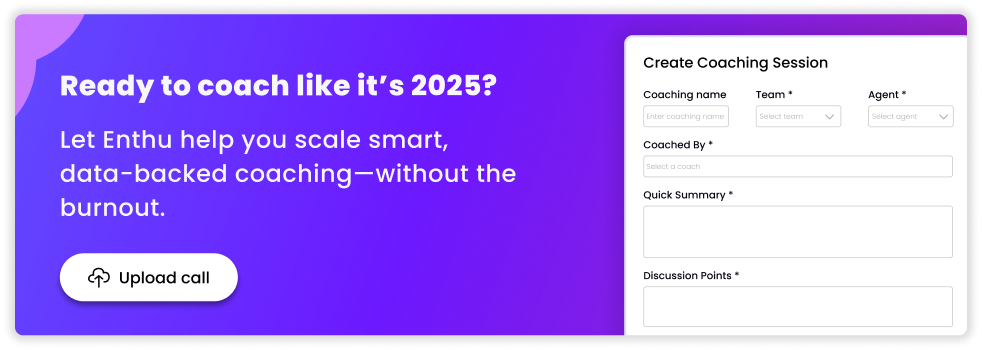
B. 7 Proven call coaching techniques that drive results
Great coaching isn’t about long lectures or vague advice.
It’s about smart, repeatable techniques that actually help agents grow.
Here are 7 tactical coaching methods that work like magic in high-performing call centers:
1. The call breakdown method
Instead of reviewing an entire 6–8 minute call, pick one or two crucial moments and coach just that.
Think of it like reviewing the game-winning play in a football match—not the whole 90 minutes.
Focus on pivotal points like the opening, objection handling, tone shifts, or the final close.
This helps agents zero in on what really matters without feeling overwhelmed by the full conversation.
Let’s say an agent struggled during a price objection. You replay that 25-second snippet where the customer pushed back, pause, and ask the agent how they’d respond differently.
Enthu.AI helps by tagging such moments using snippets, so you can pull them up in seconds. This creates targeted learning that sticks better than generic feedback.
Call snippets dashboard
Use Enthu’s transcript search to find objection-heavy calls fast.
2. Scorecard-based coaching
Use quality scorecards not as a report card, but as a coaching compass.
The goal isn’t just to grade, but to spot trends. A dip in the script adherence score over a week could indicate coaching opportunities.
Reviewing this regularly helps managers make data-backed decisions instead of guessing.
Hey Rahul, I noticed your script adherence dropped from 93% to 86% over three days. Let’s look at where you’re going off-script and whether it’s helping or hurting the flow.
You can filter calls by scorecard category and drill into where the drop occurred.
Coaching feels less like correction and more like collaborative performance tuning.
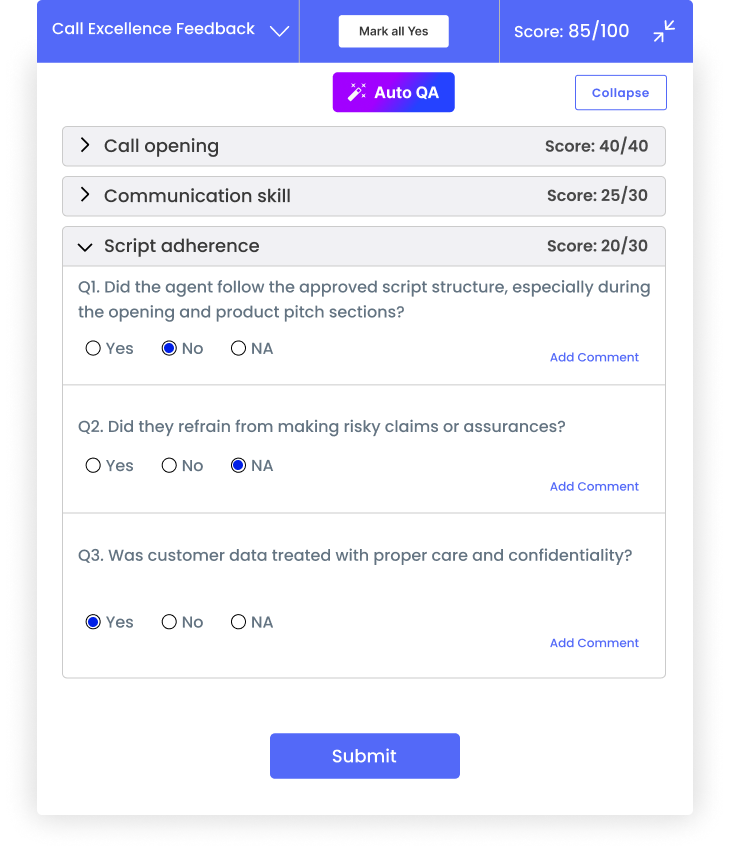
3. Silent shadowing
Let agents shadow top performers—but silently. No meetings.
No lectures. Just curated call recordings from high-performing agents.
Ask them to listen and identify 3 things they’d want to try. It turns passive listening into active learning and reduces dependence on managers.
You assign an agent three calls where top reps handle customer complaints. They notice how each rep uses pauses, tone, or specific phrasing to de-escalate the situation. Afterward, you ask: “Which part did you like best? Can you try that on your next call?”
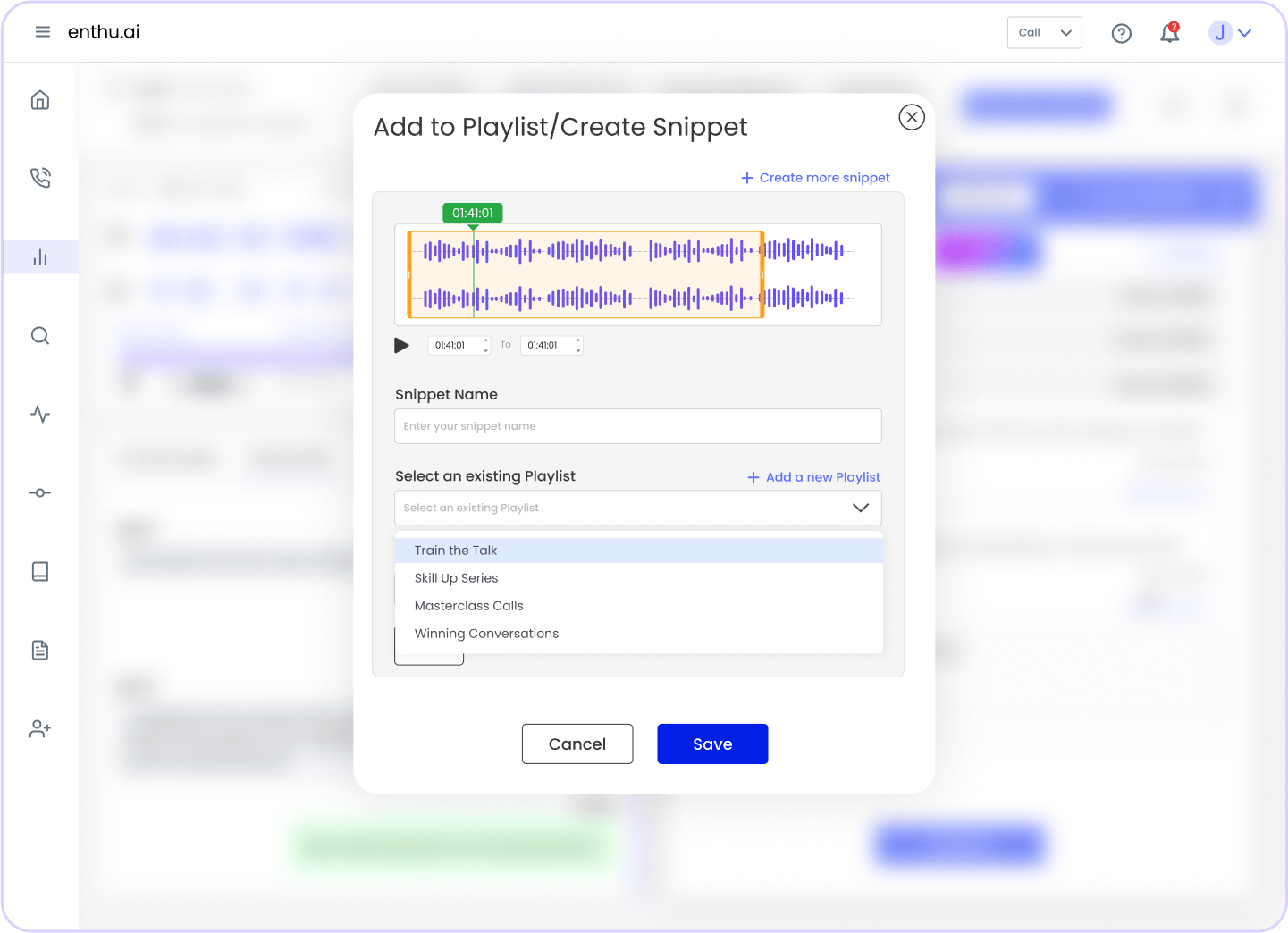
4. The “before & after” review
Instead of only focusing on what went wrong, show progress.
Take an older call recording and compare it with a recent one from the same agent.
Let them hear the difference in tone, structure, and confidence. It boosts morale and reinforces learning by highlighting what’s actually improved over time.
You pull up a call from 30 days ago where the agent fumbled during the pitch. Then, you play a recent one where they nailed it. Ask: “What’s changed in your approach?” or “What would you still tweak?” This technique isn’t just motivating—it proves that coaching is working.
3. Micro-coaching moments
Forget waiting for the monthly review.
Real learning happens when feedback is instant and bite-sized.
Micro-coaching is about dropping 1–2 line insights after a call, while it’s still fresh in the agent’s mind. This builds a habit of continuous improvement without disrupting workflow.
An agent finishes a call. You send: “Love how you paused after the customer’s objection—felt very natural.
That 15-second message can have more impact than a full sit-down.
You can quickly drop notes right after a flagged call—directly via Slack or email—without scheduling anything.
Over time, this method compounds into better habits.
6. Call center coaching with KPIs in context
Coaching should always be tied to real numbers, or it becomes abstract.
When you show agents how their behavior impacts KPIs—like AHT, CSAT, or conversion rate—it becomes easier to connect the dots between coaching and outcomes.
Your average handle time increased by 45 seconds this week, but your LTR improved. That tells me you’re taking more time to understand the customer. Let’s find a sweet spot that keeps both metrics in check.
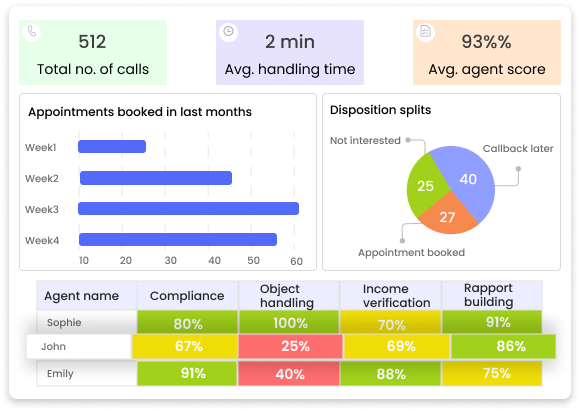
7. Coaching with follow-ups built in
One coaching session isn’t enough. The magic happens in the follow-up.
Set a micro-goal after each session and revisit it after 3–5 days. This creates accountability and a rhythm of consistent learning.
Teams that follow up on coaching see 33% higher improvement in agent performance (Gartner).
You say: “For the next 5 calls, try to end with an open-ended question. Let’s review two of those by Thursday.” Enthu.AI lets you tag calls for follow-up review and let’s you create different coaching sessions.
C. The 15-minute coaching framework that actually works
Raise your hand if you’ve ever postponed coaching because you didn’t have time.
(Yeah, same.)
But here’s the plot twist: Coaching doesn’t have to be a 60-minute calendar-eating monster.
Sometimes, 15 minutes is all you need to spark real improvement—if you do it right.
Here’s a simple, no-fluff framework that’ll help you run punchy, purposeful coaching sessions (even between back-to-back meetings).
Step 1: Prep (3 minutes)
Pull 1-2 calls aligned to the goal using QA insights or Auto QA filters.
Use your QA insights or Enthu’s Auto QA filters to shortlist calls worth discussing—no more random picks!
If the goal is “Improve call openings,” pick a call where the agent skipped the greeting or jumped right into scripting. Play the exact snippet; prompt reflection (“What did you notice?”). The goal isn’t to trap them—it’s to spark self-awareness. Let them reflect. They’ll often spot issues before you say a word. And that’s a coaching win. 1 praise + 1 improvement; tie to the moment. What worked: “Your tone was super warm—especially during the hold transfer. That’s gold.” What to improve: “Let’s pause before offering a solution next time. Ask one more probing question first. It helps customers feel heard.” Use one highlight + one area of improvement. That’s it. Define a measurable micro-goal and schedule a follow-up. For your next 5 calls, I want you to pause for 2 seconds after every objection and then respond using the empathy framework we discussed. Set expectations. Then schedule a follow-up coaching session to check progress. That’s it. 15 minutes. It’s fast. It’s focused. It works. The secret sauce? Consistency. Because even the best framework fails if it only shows up once a quarter. So you’ve realized that giving feedback once a month over coffee isn’t cutting it. Good news: Coaching isn’t one-size-fits-all—and your agents aren’t clones either. Let’s break down the real coaching formats that work in today’s fast-paced call centers (without making your reps yawn through it): Classic but still gold. Think of this as your focused, heart-to-heart session. You go deep into one rep’s strengths, struggles, and specific calls. No interruptions. No team chatter. Just two people and real talk. Hey Sam, remember that call with the customer who wanted to cancel? Let’s unpack how you handled objections—it was 80% perfect, but there’s this one moment… When to use it: Fix the pattern, not the person. If you’re spotting the same issue across multiple reps—like missed greetings or low empathy scores—bring them together. Not to shame, but to learn together. You can even role-play call snippets and turn it into a live workshop. We noticed that greeting consistency dropped across the board last week. Let’s hear a few variations and brainstorm stronger openers. Bonus: It builds team accountability. Reps coaching reps = powerful. Sometimes, the best feedback doesn’t come from managers—it comes from peers who get it. Set up “buddy reviews” where two reps swap calls and give each other constructive feedback. You’ll be surprised how much insight they share. I noticed you paused for just the right amount of time when the client was frustrated—that calmed things down instantly. I’m gonna try that too. Use it to: Because growth starts with self-awareness. Let reps listen to their own calls with scorecards. Ask them to reflect and rate themselves. You’ll find many of them already know where they slipped—this just makes it real. I totally rushed that closing line. I didn’t even ask if they needed help with anything else. Noted. (Yup, you can coach… while you sleep.) Manual reviews take time. A lot of time. That’s why platforms like Enthu let you create automated coaching sessions—no more jumping between tools or digging through random call snippets. You decide what needs improvement (say, “Objection handling” or “Better rapport-building”), and Enthu helps you: It’s structured, it’s scalable, and it saves you hours—while making coaching more consistent than ever before. At the end of the day, coaching isn’t a checkbox—it’s your secret weapon. The difference between a struggling team and a standout one? Consistent, smart, and human-first coaching. Whether it’s a 15-minute sync or an automated session from Enthu, what matters most is that your agents feel seen, not scrutinized. Heard, not hurried. So stop treating coaching like a calendar burden. Because when coaching clicks, everything else follows—better calls, happier customers, and reps who actually want to stick around. Now go make it count. 1. How do you coach a call center agent ? 1. Coach your service team strategically 2. Micro-coach them throughout the day 3. Have a specific purpose 4. Start off on the right foot 5. Teachable skills 6. Creating an action plan 7. Role Plays 2. What is coaching in a call center? Call center coaching is the process of providing guidance, feedback, and training in order to improve agent performance and reach their potential, with a focus on customer service, sales, and communication skills. 3. How can I improve myself as a call center agent? To improve as a call center agent, focus on improving your communication skills, product knowledge, and customer service skills. Practice active listening, ask questions, and seek feedback to continuously improve your performance.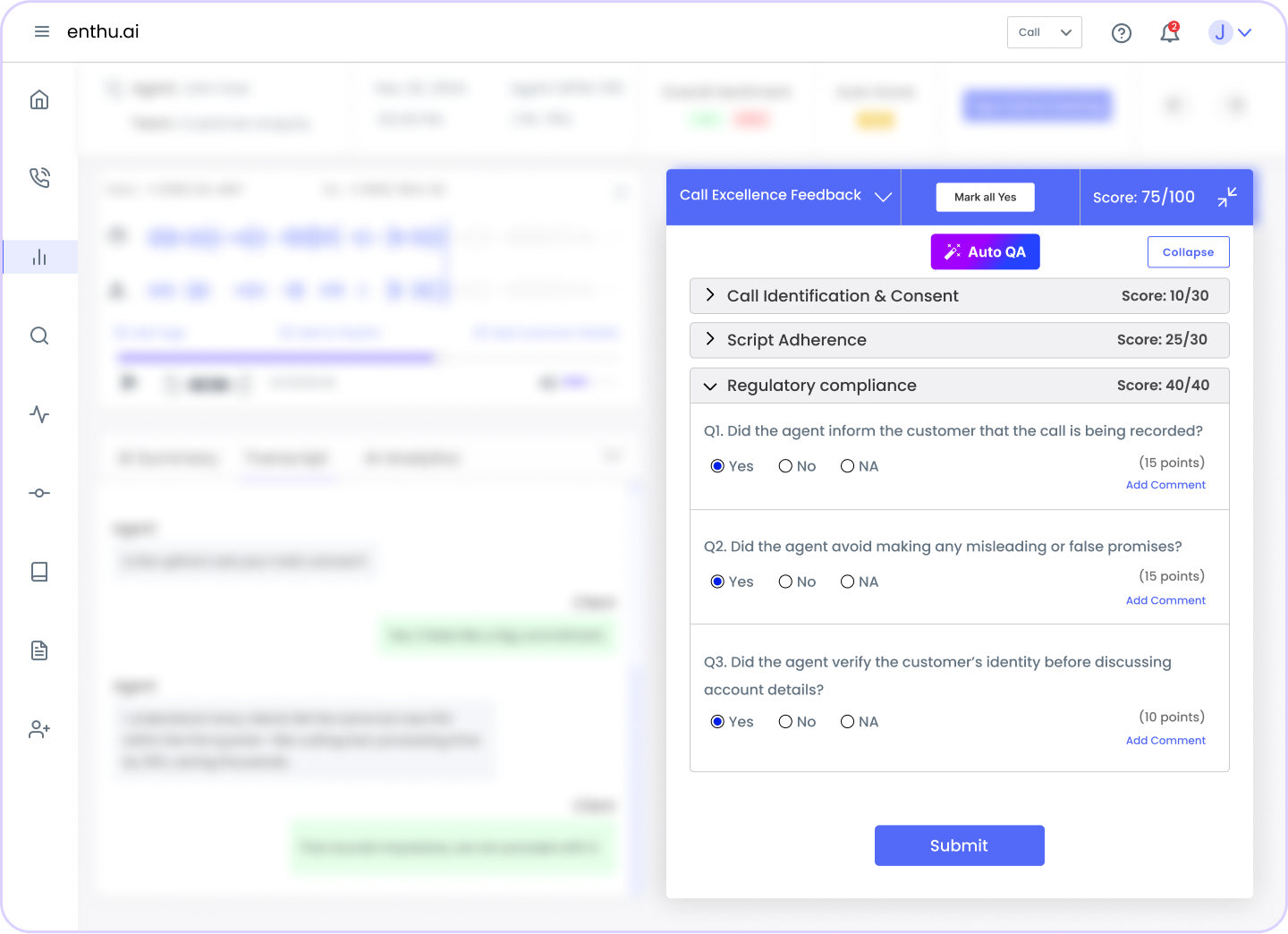
Step 2: Listen together (4 minutes)
Step 3: Targeted feedback (4 minutes)
Step 4: Agree on 1 actionable takeaway (3 minutes)
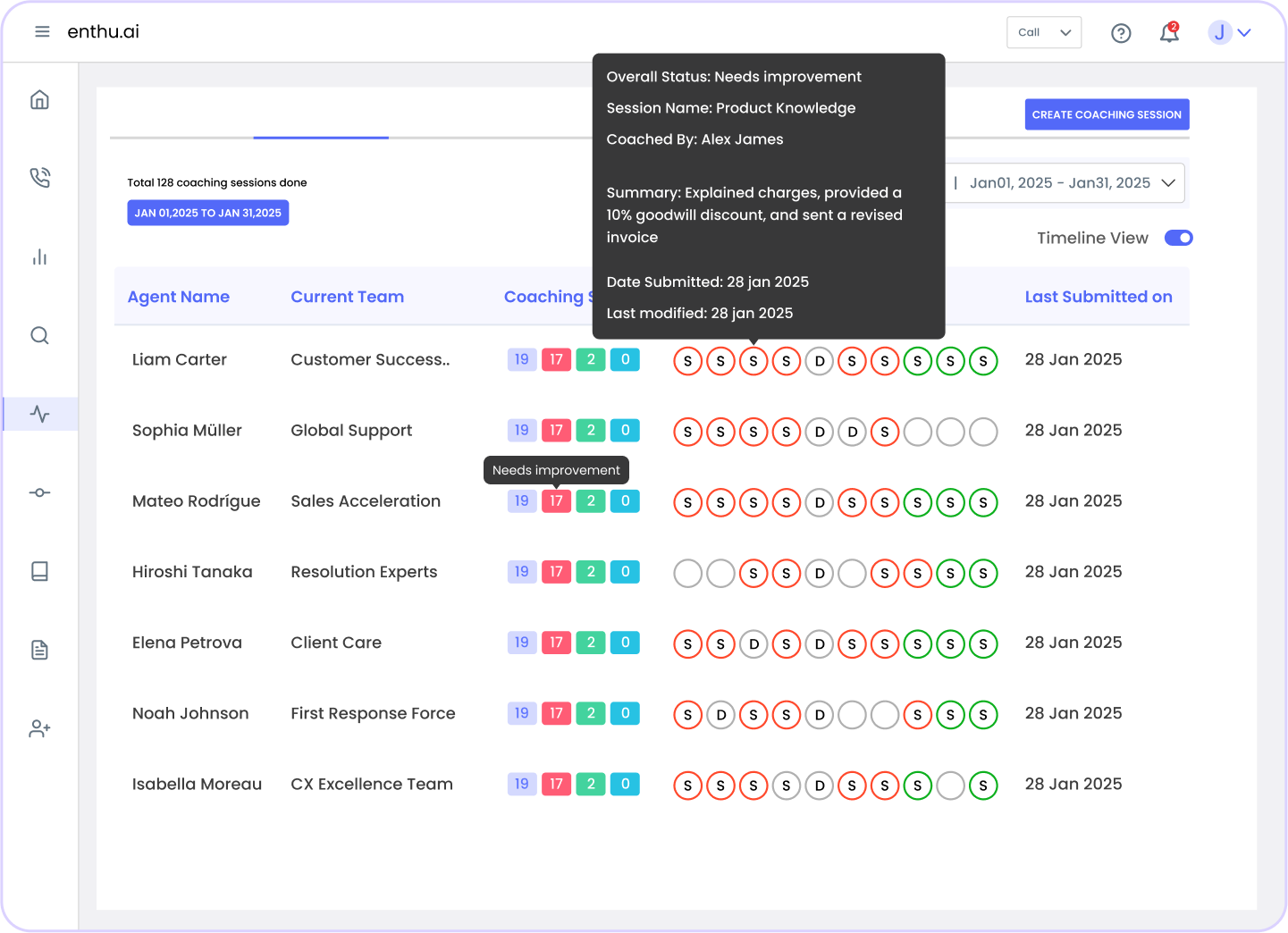
D. Types of call coaching you should be using
1. One-on-One coaching
2. Group coaching
3. Peer-to-peer coaching
4. Self-coaching
5. Automated coaching sessions
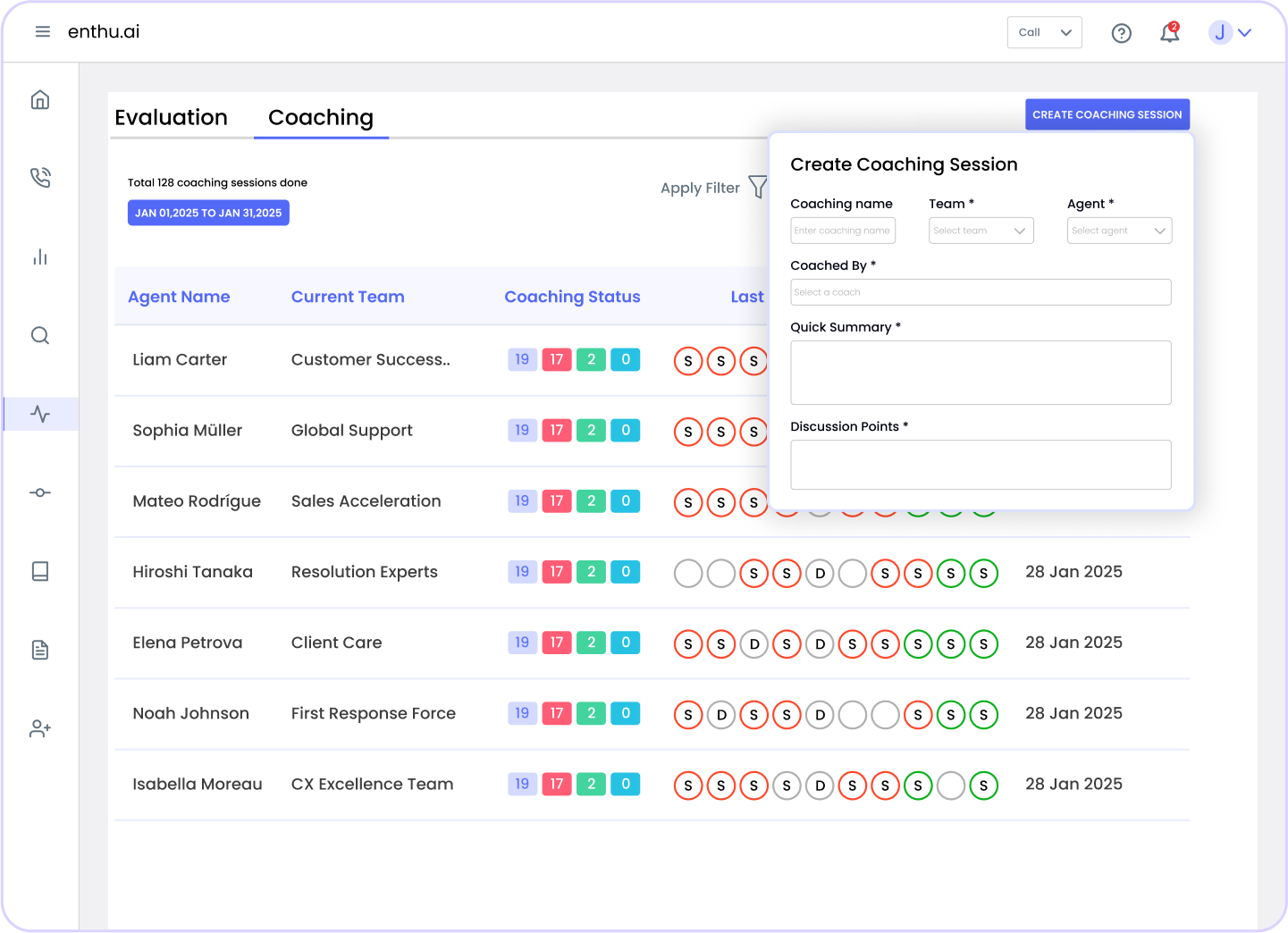
Conclusion
Start treating it like the performance engine it actually is.FAQs
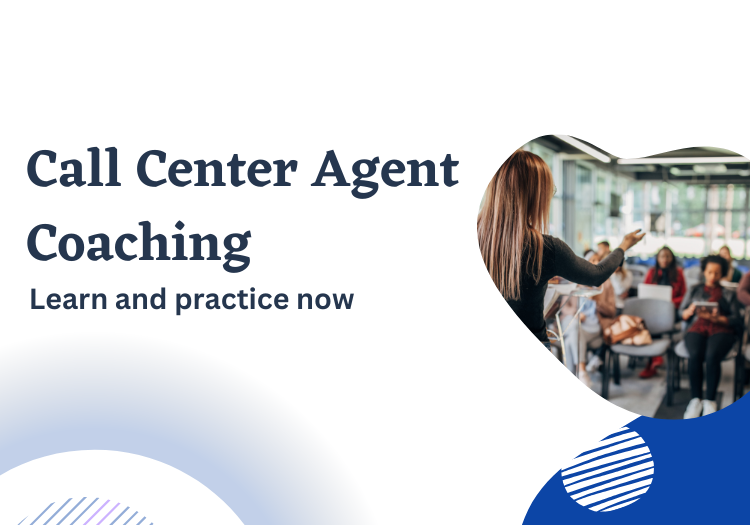

 On this page
On this page
